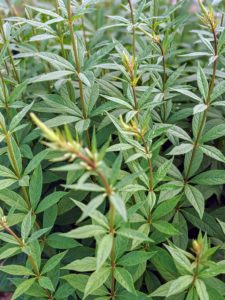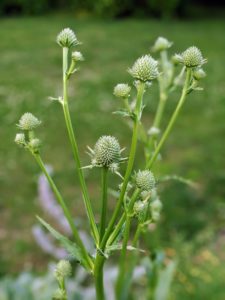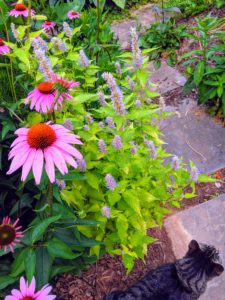The temperature is rising into the 90’s and soon will be reaching into the three digits with humidity thick enough to soak clothing by 9am. Thank goodness for air conditioning and the backyard pool! But if you were a plant, what would you do? Most plants will go dormant in the heat of the summer. Their leaves and blooms will yellow and drop off, and the plant will not put out any new growth until more favorable conditions return.
Your garden need not be in summer dormancy. There are plenty of plants that thrive in the heat and humidity of Southeastern, PA. Here are a few that I would recommend as I have grown them for many years:
Heat tolerant plants for the sun:
Culver’s root (Veronicastrum virginicum)
Spires of either pink/lavender or white flowers adorn this handsome perennial. Easily grown in most soils, it is well-behaved as it does not crowd its neighbors nor spread around your garden. The leaves are rather interesting as they “whirl” around the stem. Attractive to butterflies and bees, this tall plant (5’ to 6’) should be placed at the back of the border to let it shine. Cut down Culver’s root in early winter to keep your garden tidy or leave it up to offer native pollinators a place to shelter.
Rattlesnake master (Eryngium yuccifolium)
The first time I saw this, I could not believe that it was a native plant. It looks like more of a dessert dweller than a plant from this region. The leaves resemble those of yuccas (thus the name) and the flowers are like thistles. The entire plant is a greyish blue/green color – who doesn’t love that? This perennial belongs to the carrot family and like many family members attracts all types of pollinators. Plant rattlesnake master in well-drained soil in full sun. It’s great planted with beardtongue (Penstemon digitalis) and blue star (Amsonia hubrichtii).
Anise hyssop (Agastache foeniculum)
The entire plant is fragrant and smells of anise. Who would not want that? I particularly like to grow the gold version ‘Golden Jubilee’ which will come true to seed – seedlings will have yellow foliage too. Anise hyssop thrives in poor soil but not winter wet soil. Not everyone will find the combination of pink puff flowers and gold foliage a winning combination. If you don’t, just pinch the flower stalks off if they offend you. Bees love the flowers and birds will snack on the seeds at the end of the summer. Be careful, as this will seed around.
Heat tolerant plants for the shade:
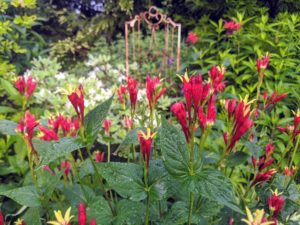 Indian pink (Spigelia marilandica)
Indian pink (Spigelia marilandica)
For that elusive punch of red in the summer woodland landscape, there is no other than the blooms of the Indian pink. But wait, aren’t the flowers red? The pink refers to the flower shape– pinked. Indian pink is a favorite of hummingbirds and yours if you like a well-behaved plant with lush green leaves. It will self-sow if it finds your garden favorable. I have several clumps that magically appeared in the last seven years. Transplant Indian pink in spring or fall less you want to find the entire plant black the next morning.. Clay soils do not bother this plant, and Indian pink can grow in deep to light shade. It is a great companion with turtleheads (Chelone lyonii) and sedges (Carex sp.).
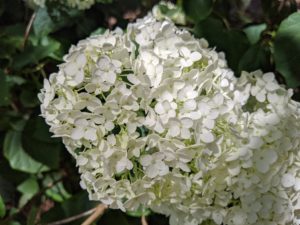 Smooth hydrangea (Hydrangea arborescens)
Smooth hydrangea (Hydrangea arborescens)
I’m sure by now that you are tired of seeing your hydrangea melting in this heat. Don’t be discouraged. Our native hydrangea and its cultivated varieties are here to provide you with that puffy punch without the droop. ‘Annabelle’, ‘Invincibelle’ and now, ‘Haas’ Halo’ are wonderful plants for foundation planting. The good news is that the smooth hydrangea blooms on new wood. Don’t worry about sheltering flower buds in winter. Give the Smooth hydrangea some room (5ft x 5ft) and let it impress you!
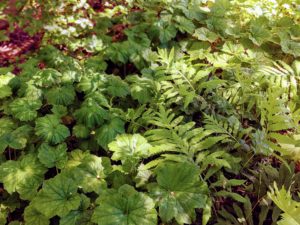 Hairy alum root (Heuchera villosa)
Hairy alum root (Heuchera villosa)
I cannot say enough about this hairy alum root except that it has a really bad common name. Are you looking for a coarse foliage plant in the shade that’s not a hosta? If the answer is yes and you would prefer some drought tolerance, then the hairy alum root is a great choice. Most nurseries would carry ‘Autumn Bride’ hairy alum root and it is a great performer. I’ve placed it under trees where it produces large hairy tropical leaves. When planted in some sun, the leaves are smaller, but will produce more blooms. This native perennial plays well with ferns and creeping phlox. For a study of alum roots and the many varieties available, go to Mt Cuba Center’s Plant Trials.


